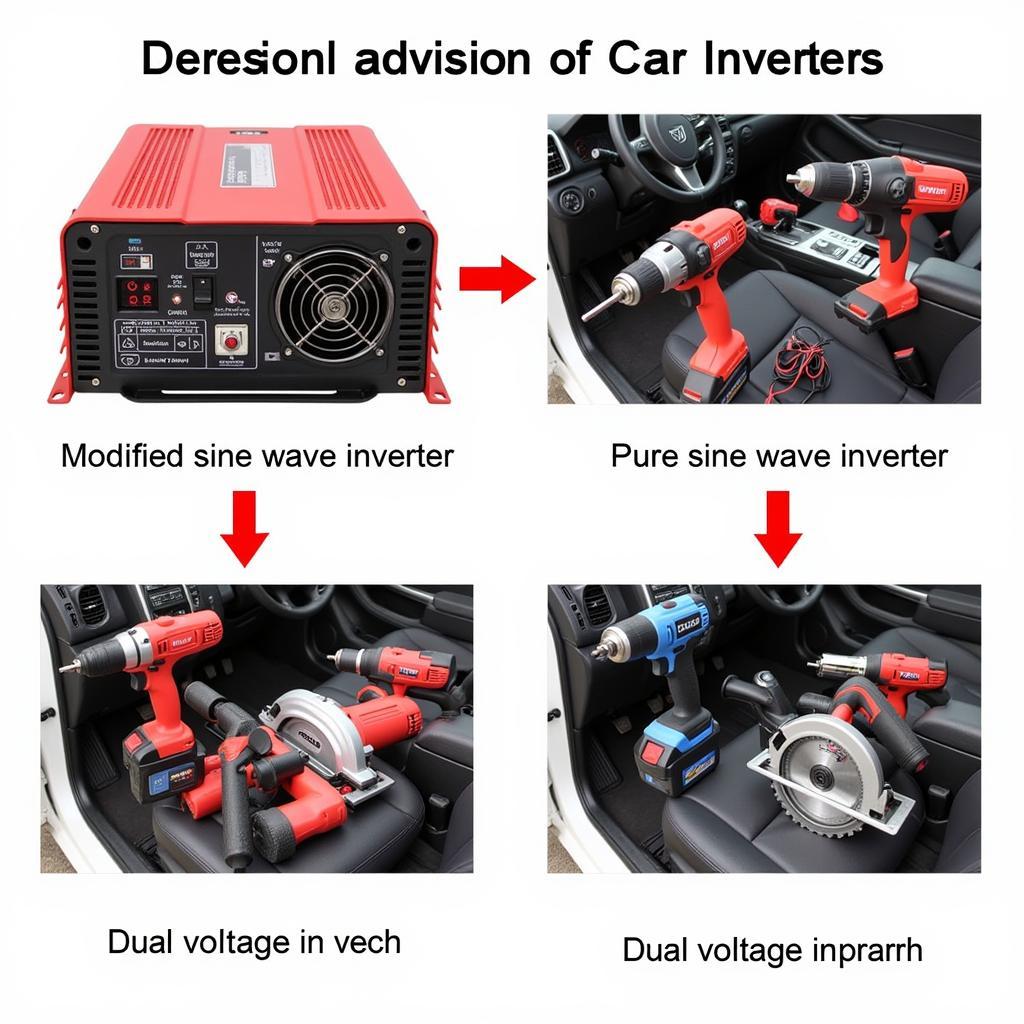Powering your power tools with a car inverter opens up a world of possibilities, whether you’re a professional on the go or a DIY enthusiast tackling projects away from home. This guide explores the ins and outs of using power tools on a car inverter, from choosing the right inverter to safety precautions and troubleshooting common issues.
Understanding Car Inverters and Power Tool Compatibility
Before plugging in your drill or saw, it’s crucial to understand how car inverters work and their limitations. Inverters convert the DC power from your car’s battery into AC power, similar to what you find in your home outlets. However, not all inverters are created equal.  Different types of car inverters suitable for powering various power tools.
Different types of car inverters suitable for powering various power tools.
Power tools vary significantly in their power requirements. Smaller tools like cordless drills and sanders require less wattage than larger tools like circular saws and angle grinders. Choosing an inverter with sufficient wattage is critical to avoid overloading the inverter or damaging your tools. Look for the wattage rating on your power tool and choose an inverter that can handle at least that much, preferably with some headroom.
use car battery and power inverter to charge tools
Choosing the Right Car Inverter for Your Power Tools
Selecting the correct car inverter involves considering several factors:
- Wattage: Determine the combined wattage of the tools you plan to use simultaneously.
- Waveform: Pure sine wave inverters are generally recommended for power tools, especially those with sensitive electronics. Modified sine wave inverters are cheaper but can damage some tools.
- Outlet Type: Ensure the inverter has the correct outlets for your power tool plugs.
- Safety Features: Look for inverters with overload protection, short circuit protection, and low-voltage shutdown.
Safe Practices When Using Power Tools with a Car Inverter
Safety should always be a top priority when working with power tools and car inverters.
- Ventilation: Ensure adequate ventilation to prevent overheating.
- Car Engine: Keep your car engine running while using the inverter to avoid draining the battery.
- Grounding: Proper grounding is essential to prevent electrical shocks.
- Overloading: Never overload the inverter by exceeding its wattage capacity.
- Cables: Use heavy-duty cables to connect the inverter to the battery.
car power inverter for power tools
Troubleshooting Common Issues
Occasionally, you may encounter issues when using power tools on a car inverter. Here are some common problems and solutions:
- Inverter shuts off: This usually indicates an overload. Reduce the load or use a higher-wattage inverter.
- Power tool doesn’t work: Check the inverter’s connections, fuses, and the power tool itself.
- Burning smell: Immediately disconnect the inverter and check for overheating or damaged cables.
Can I use any power tool with a car inverter?
No, you should choose power tools with wattage compatible with your car inverter.
What type of car inverter is best for power tools?
Pure sine wave inverters are generally recommended.
How do I calculate the wattage I need?
Check the wattage rating on your power tools and add them together.
easypower 6-in-1 car charger tool
“Always prioritize safety when using power tools with a car inverter,” advises John Smith, a certified automotive electrician. “Proper grounding and ventilation are crucial for preventing accidents.”
Maintaining Your Car Battery When Using Power Tools
Regularly check your car battery’s health, especially if you frequently use power tools with a car inverter. “A healthy battery is essential for reliable power and prevents potential damage to both your inverter and power tools,” explains Jane Doe, a senior automotive engineer at DiagFixPro. “Consider investing in a battery tester to monitor its condition.”
In conclusion, using power tools on a car inverter provides a convenient power source for various applications. By understanding the basics, choosing the right equipment, and following safety guidelines, you can safely and effectively power your tools wherever your work takes you. Remember to select an inverter with appropriate wattage, prioritize safety, and maintain your car battery for optimal performance.
FAQ
- Can I run a refrigerator off my car inverter?
- What’s the difference between a modified sine wave and a pure sine wave inverter?
- How long can I run power tools on my car battery?
- Is it safe to leave my car inverter plugged in all the time?
- What size cables do I need for my car inverter?
- How can I prevent my car battery from draining when using an inverter?
- Are there any specific power tools not recommended for use with inverters?
Need more assistance? Contact us via WhatsApp: +1(641)206-8880, Email: [email protected] or visit our office at 910 Cedar Lane, Chicago, IL 60605, USA. Our 24/7 customer support team is ready to help.

Leave a Reply